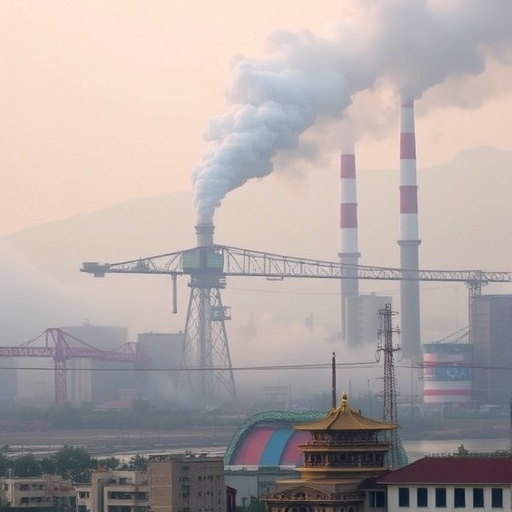In the heart of central China, unraveling the silent menace lingering in everyday air, a new comprehensive study has spotlighted the health hazards posed by toxic metals embedded in fugitive dust particles arising from mining and industrial activities. This groundbreaking research meticulously examines the source-oriented risks these dust particles present to both children and adults, promising to redefine public health perspectives in heavily industrialized zones.
Fugitive dust refers to tiny particles released into the atmosphere primarily through anthropogenic activity such as mining operations, smelting processes, and other industrial undertakings. Unlike controlled emissions that are released through stacks or vents, fugitive dust disperses passively, escaping conventional capture systems and settling onto residential areas, playgrounds, and agricultural land. The consequential inhalation or ingestion of this dust places local populations at heightened risk of exposure to hazardous substances often invisible to the naked eye.
The scientific investigation centered on an industrial-mining region in central China, a geographical area historically known for its rich mineral deposits as well as burgeoning industrial growth. The researchers collected samples across multiple sites, differentiating fugitive dust composition according to various source contributions. This source-apportionment approach allows for a granular understanding of which specific activities most significantly contaminate the environment and to what degree different metals accumulate in dust particles.
Toxic metals such as lead (Pb), cadmium (Cd), arsenic (As), and mercury (Hg) dominate the findings, each notorious for their long-term health implications. Lead, for instance, is well-documented for its neurotoxic effects, especially in developing children where it hampers cognitive function and behavior. Arsenic’s carcinogenic properties and its association with cardiovascular diseases add to the grave concerns, while cadmium’s link to kidney dysfunction and bone damage further complicates the toxicological landscape.
Children, the study affirms, bear a disproportionately high burden of risk due to behavioral and physiological factors that intensify exposure and adverse outcomes. Their hand-to-mouth activities, outdoor play habits, and developing organ systems make them especially vulnerable to the toxic metals carried by fugitive dust. Adults, though more resilient in some respects, still face chronic health challenges that can culminate in respiratory ailments, systemic toxicity, and an elevated burden of cancer risk.
Importantly, the research takes a novel step by integrating source-orientation into risk assessment models. Rather than treating environmental dust as a uniform hazard, this method identifies which industrial actions—whether mining excavation, ore processing, or smelting emissions—contribute most severely to toxic metal burden in the environment. This differentiation has significant policy implications, as it pinpoints where stricter emission controls or remediation efforts would yield the greatest public health benefit.
Analytical techniques employed in the study included advanced geochemical fingerprinting and quantitative human health risk assessment modeling. The dust samples underwent rigorous chemical analysis using inductively coupled plasma mass spectrometry (ICP-MS), enabling precise quantification of trace metals. This data was then fed into exposure models that calculate risks via inhalation, dermal contact, and inadvertent ingestion pathways, tailored separately for children and adults.
The findings paint a complex picture of environmental injustice. Industrial and mining operations, while generating economic value, impose a hidden health tax on the local populations. The study notes that socioeconomic status and proximity to contaminant sources exacerbate exposure effects, hinting at a compounded vulnerability that demands urgent attention from both regulatory agencies and public health officials.
Furthermore, the study explores temporal and spatial variations in toxic metal concentrations, revealing that dust contamination fluctuates seasonally and according to wind patterns. Dry seasons tend to elevate fugitive dust levels as surface material is more easily resuspended into the air, suggesting that communities might face intermittent yet intense exposure episodes rather than constant low-level contamination.
This nuanced understanding challenges simplistic assumptions about environmental pollution, advocating for dynamic monitoring systems that incorporate meteorological and operational variables to predict and mitigate exposure risks more effectively. Developing early warning systems and community engagement strategies becomes imperative to minimize health impacts, particularly for high-risk groups like children.
The public health dimensions outlined in this investigation resonate beyond China’s borders, mirroring challenges faced by mining-industrial regions worldwide. As developing economies balance industrial growth against environmental stewardship, studies like this illuminate the costs hidden in airborne particulate matter—a public health threat demanding concerted global research and policy action.
In light of this work, the authors recommend robust environmental management frameworks that prioritize emission reduction at the source alongside community-level interventions. Soil stabilization techniques, green buffer strips, and stricter operational protocols during high dust-generating activities could substantially mitigate toxicity. Moreover, regular biomonitoring and health surveillance in exposed populations could aid early diagnosis and prevention strategies.
The research also touches upon the interplay between environmental contamination and climate change. Increasing temperatures and altered precipitation patterns may influence dust generation and metal mobilization, compounding exposure risks. This calls for integrated approaches combining environmental science, public health, and climate resilience planning to safeguard vulnerable populations in mining-industrial belts.
Finally, the study emphasizes the urgent need for international cooperation to share best practices, technological innovations, and regulatory strategies aimed at reducing fugitive dust hazards. Addressing these factors is not merely a local or national challenge but a global imperative as industrial pollution continues to threaten human health and ecosystem integrity worldwide.
As industrialization advances, the invisible peril of toxic metals in airborne dust unveils a silent epidemic poised to affect millions. This study’s rigorous, source-oriented approach offers a critical roadmap for targeted interventions, transforming how societies understand and combat the health risks embedded in the very air we breathe.
Subject of Research: Source-oriented health risks of toxic metals in fugitive dust for children and adults in a mining-industrial region of central China
Article Title: Source-oriented health risks of toxic metals in fugitive dust for children and adults in a mining-industrial region of central China
Article References:
Song, M., Chen, X., Liu, S. et al. Source-oriented health risks of toxic metals in fugitive dust for children and adults in a mining-industrial region of central China.
Environ Earth Sci 84, 534 (2025). https://doi.org/10.1007/s12665-025-12544-2
Image Credits: AI Generated




